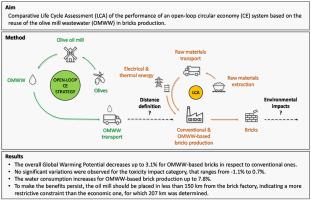Journal of Cleaner Production ( IF 9.7 ) Pub Date : 2021-10-18 , DOI: 10.1016/j.jclepro.2021.129388 Luca Silvestri 1 , Antonio Forcina 2 , Gianpaolo Di Bona 3 , Cecilia Silvestri 4

|
The olive mill wastewater (OMWW) is one of the highly pollutant residue in olive oil producing countries around the Mediterranean Sea, due to its large organic load and the presence of a variety range of contaminants. The valorization and the recycling of this by-product can represent a successful strategy for the implementation of circular economy models in the agri-food industry. For this purpose, the incorporation of OMWW in the brick-making process represents a promising solution, which not only can avoid the impacts due to its disposal but also reduce the heat required during the ceramic production process, resulting in lower greenhouse gas emissions and economic benefits. However, many factors should be considered, including the transport activity of the OMWW from the mill to the factory that can affect both the environmental and economic benefits. The present study aims to assess the performance of an open-loop circular economy system based on the reuse of the OMWW in the fired clay brick production, in terms of technical feasibility, environmental and economic sustainability. To evaluate environmental impacts, a comparative Life Cycle Assessment is performed between a conventional production and a system in which OMWW is directly integrated in the brick-making process, considering scenarios with different transport distances. Furthermore, an economic sensitivity analysis was implemented, taking into account energy savings and the additional costs due to transport. The results showed that the overall Global Warming Potential (GWP) decreases up to 3.1% for OMWW-based bricks with respect to conventional ones, as well as the Abiotic Depletion of fossil fuels is reduced by 4.3%. On the other hand, no significant variations were observed for the toxicity impact category, that ranges from −1.1% to 0.7%. Furthermore, the water consumption increases for OMWW-based brick production up to 7.8%. Finally, in terms of GWP, it has been found that to make the benefits persist, the oil mill should be placed in a distance of less than 150 km from the brick factory, indicating a more restrictive constraint than the economic one, corresponding to a distance of 207 km.
中文翻译:

在陶瓷工业中再利用橄榄厂废水的循环经济战略:工厂选址如何有利于环境和经济绩效
橄榄厂废水 (OMWW) 是地中海周围橄榄油生产国的高污染残留物之一,因为其有机负荷大且存在多种污染物。这种副产品的增值和回收可以代表在农业食品行业实施循环经济模式的成功战略。为此,在制砖过程中加入 OMWW 是一种很有前景的解决方案,不仅可以避免其处置带来的影响,还可以减少陶瓷生产过程中所需的热量,从而减少温室气体排放和经济好处。但是要考虑很多因素,包括从工厂到工厂的 OMWW 运输活动,这会影响环境和经济效益。本研究旨在评估基于 OMWW 在烧制粘土砖生产中再利用的开环循环经济系统的技术可行性、环境和经济可持续性。为了评估环境影响,考虑到不同运输距离的场景,在传统生产和 OMWW 直接集成到制砖过程中的系统之间进行了比较生命周期评估。此外,还进行了经济敏感性分析,将节能和运输带来的额外成本考虑在内。结果表明,整体全球变暖潜势(GWP)下降至 3。与传统砖相比,基于 OMWW 的砖减少了 1%,以及化石燃料的非生物耗竭减少了 4.3%。另一方面,没有观察到毒性影响类别的显着变化,范围从 -1.1% 到 0.7%。此外,基于 OMWW 的砖生产用水量增加了 7.8%。最后,在 GWP 方面,发现为了使效益持续存在,油厂应放置在距砖厂 150 公里以内的位置,表明比经济约束更严格的约束,对应于距离 207 公里。此外,基于 OMWW 的砖生产用水量增加了 7.8%。最后,在 GWP 方面,发现为了使效益持续存在,油厂应放置在距砖厂 150 公里以内的位置,表明比经济约束更严格的约束,对应于距离 207 公里。此外,基于 OMWW 的砖生产用水量增加了 7.8%。最后,在 GWP 方面,发现为了使效益持续存在,油厂应放置在距砖厂 150 公里以内的位置,表明比经济约束更严格的约束,对应于距离 207 公里。











































 京公网安备 11010802027423号
京公网安备 11010802027423号